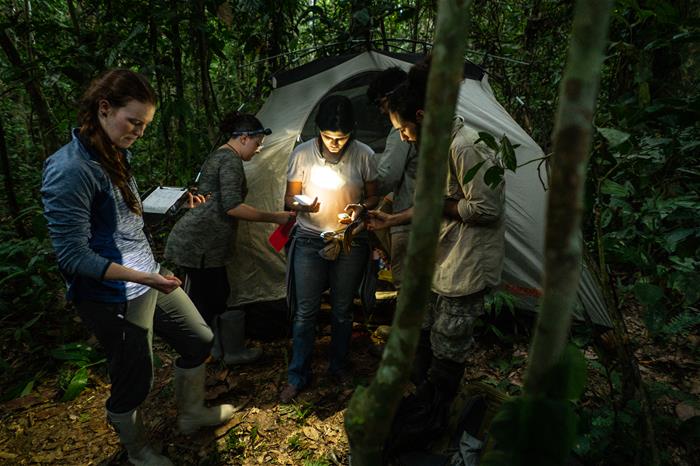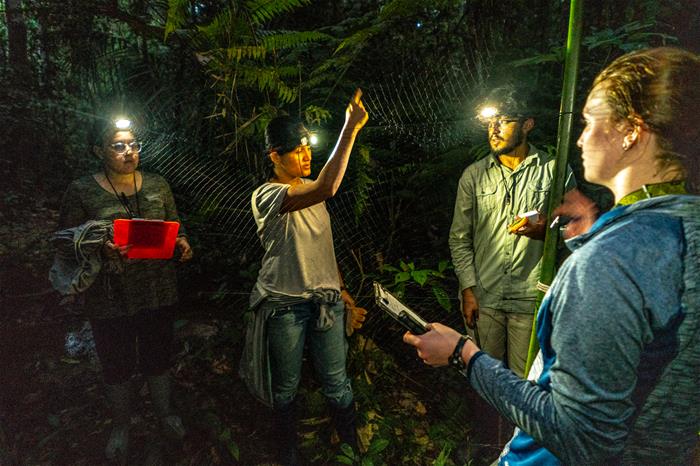
Dr. Mrinalini Erkenswick Watsa is a researcher for the San Diego Zoo Wildlife Alliance focusing on the development of affordable genomic tools for wildlife conservation. She and her colleagues have received multiple Moore Foundation grants, including projects such as developing a genomic technology laboratory for wildlife population surveillance and pathogen screening in Peru. She also co-founded the nonprofit organization Field Projects International, which offers research training programs in field biology. You can find her on Twitter @surroundscience.
In this installment of Beyond the Lab, Dr. Watsa discusses her sources of inspiration and the importance of maintaining a flexible career outlook.
What made you want to become a researcher?
My parents describe me as the kid who was always asking why. I was probably painful to be around. I wanted a lot of reasons for why things happened, appreciated the logic behind the decisions they were making, and did not take things at face value. I think this has made me really enjoy the research process – I like the idea of reading, saying, “Huh, I wonder why that is?” and then digging in and making connections to discover what could be good questions or answers to pursue.
Have those motivations changed at all? What keeps you going today?
When you’re in college, it’s so liberating because you can look at and study anything. But it’s also a little unnerving because you drift, and it’s hard to find one interest that anchors you down. For me, the closest thing to an anchor was wildlife conservation. I really enjoy connecting a very academic and urban field with the applied portion of conservation (protecting an area and working with communities). Trying to take the best things about the science I was trained to do and transforming them until they’re having impact on the ground – that’s what I really love about what I do now.

What scientific problems are you and your colleagues most interested in solving?
When you think about the threats a charismatic target species like an elephant or a giraffe face in their environments, you can identify a myriad of different ways humans and climate change affect them. What is not often considered is how we know how well a population of a target species is doing. If we went in and did something about those threats, how would we actually know that our intervention worked? That’s what my work is centered on - figuring out practical ways to give field biologists of a variety of backgrounds some novel and effective tools to assess how well a population is doing over time.
My favorite tool is genetics, which translates the genetic makeup of an animal into something functional for field biologists to apply towards conservation. Ultimately, it goes beyond the scientific accuracy or merit of the tool and comes down to common sense, grounding, and life experience that determines whether you’ve picked the best practical tool – will people actually use it?
What sort of challenges or limitations do you face in your field?
The biggest challenge I face in my field is twofold – it has to do with access to the right to make an impact, and access to the funding to allow one to continue to do so. My origins and training are not a combination I see in the workspace around me, so my normal isn’t normal to most of my colleagues. While this can feel isolating, it’s also exciting to have worked hard to have a seat at an influential table. I try to apply this privilege and my life experiences to broaden access to tools among communities that are traditionally excluded from such access, and to work towards more equitable funding for them to do what can typically be a very expensive type of science.
Has anyone inspired you or shaped your journey?
It’s been a series of people, but when I was younger, I was most inspired by the conservationist Gerald Durrell. He established the Jersey Zoo and documented the process of making zoos do applied conservation in a series of excellent books that I read voraciously. It was the most magical way of looking at life, because he really celebrated the odd and unusual-looking things, or sometimes even the most boring-looking things in an environment just because they had an incredible life cycle or physiology or conservation status. I thus grew up convinced that in order to do something meaningful, you had to take a lot of risks. You might end up being the only person doing it or the only person who looks like you doing it, which is a rather common thing in my field, but it’s still worth doing.
Nothing that I’ve done so far was achieved alone. I started Field Projects International in 2013, and it is one of the single most rewarding decisions I’ve ever made. Each year, I get to meet 20-30 college students or recent graduates and work with them in the Amazon rainforest. These are people I’ve only ever known in that space. I have no idea what they look like when they’re clean! They’ve helped multiply everything I do by 20 or 30, as we do everything as a team. I’ve enjoyed watching them go off in different directions and continue to do amazing things, and I’ve leant my support to as many of their endeavors as I can.
Additionally, I’m fortunate to have a spouse (Dr. Gideon Erkenswick) who is incredibly supportive. I’ve taken so many risks with my career, while managing to grow our family, and it has been amazing to have a supportive partner who shares my career and visions for the future – it just multiplies the impact we can have on the world.

What advice would you give to young researchers?
I used to answer this question keeping the 19-year-old me in sight – just beginning college, just figuring out what I was doing, and thinking about what I would have wanted to hear. But as I’m learning now, the challenges just keep coming even once you find your career. I think careers like these aren’t friendly to a lot of things in life, like moving or having children or pets that need you to be around them. You may keep finding that this world of academic research or conservation biology almost feels designed for people who don’t do any of those things. I would say that while you want to stick it out, you don’t need to stick it out forever either. There might be situations where it is okay to say you’ve given this several years, but this particular situation isn’t going to change enough to allow you to live a full life, and so you might want to do something else.
We’re always asked what we want to be when we grow up, as if there’s one answer. Recently my twins decided that they each wanted to be at least four different things, and I thought that was pretty cool – it’s progress. That’s the biggest thing I tell any of my students is that you can be a mom, you can be the only brown person in an entirely white room, and still win respect – you can be a lot of different things and you don’t just have to choose one way. You might be only one of three people that takes a particular route, but that’s okay as long as you get there. Be everything.
Where do you see yourself in five years?
At the moment, some of the projects I’m working on are very much in the realm of, “Can you really do that?” In five years, I’d like a few of those things to have panned out and moved to the realm of other people being able to adopt them. The most wonderful thing about working with genetics at this level is that while what you develop can be pretty species-specific, the pipeline you develop can be applied to any genome. There are so many species that need help, and there are many groups applying different techniques to get there. If I can make it work, I think it’s something that could be replicated by a lot of groups very quickly for many species and have a really big impact. That’s my hope!
.jpg?sfvrsn=3f75610c_1)
Images of Dr. Watsa and her team in the field are courtesy of Ryan Phillips.

Message sent
Thank you for sharing.